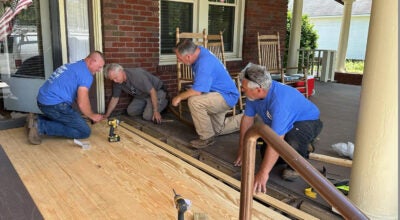Is retail right? Report encourages Granite Quarry to go after grocery store
Published 12:00 am Tuesday, June 10, 2014
GRANITE QUARRY — A team of graduate students assessing opportunities in Granite Quarry’s central business area recommends a grocery store and other retail development at the former Eastside Kwik Stop.
Paul Fisher, chairman of Granite Quarry-based F&M Bank, agreed with the team’s conclusions and said the abandoned gas station site on North Salisbury Avenue is key for building on the recent addition of Price Pharmacy, a medical office building under construction and a Family Dollar store on its way.
“If we could clean up the gateway,” Fisher said after the students presented their report Monday night, “this town would change overnight.”
University of North Carolina graduate students Michelle Audette-Bauman, Brittany Bennett and Wil Heflin prepared their report, “Granite Quarry, N.C.: Opportunities for Downtown Revitalization” as part of course work this spring. They were part of the School of Government at UNC-Chapel Hill.
Audette-Bauman and Bennett walked through highlights of their work for Monday’s meeting of the Granite Quarry Planning Board. Heflin, who is getting married, could not attend.
Also on hand to answer questions was Rory Dowling, project manager of the Development Finance Initiative for the UNC School of Government.
Sitting in the audience, Fisher congratulated the students on their work, the presentation and the details contained in the report — all of which were done free of charge for the town.
“I agree with Paul,” Planning Board Chairman Bill Ketchie said. “We give you an ‘A.’ ”
The students’ work focused on several goals, such as aesthetic improvements to the downtown, looking at the community’s desire for a grocery store and suggesting ways to attract downtown visitors.
In the end, the team said all those goals could be accomplished with a redevelopment of five parcels including and adjacent to the former Eastside Kwik Stop.
The graduate students also investigated what impact a non-taxed municipal service district could have on the town. They concluded an MSD would have little effect, unless it were funded by a MSD tax, unrestricted town funds or private contributions.
Fisher, whose bank is one of the larger property owners in the town’s outlined MSD, also agreed with that conclusion.
To start a train toward revitalization, the people who have an investment already in place must make the first investment, Fisher said.
He said the bank would support a MSD tax. But Fisher warned the town should not find itself with revenues generated from a MSD tax without having a master plan for what to do with those funds.
And any vision or plan should have, Fisher said, goals set out in priority — first, second, third, fourth and so on — so they can be addressed and accomplished one at a time.
Dowling agreed that with a taxed MSD, a vision would be key and that type of planning alone could take six months to a year.
According to the graduate students’ figures, a MSD tax of 5 cents per $100 valuation would have the potential of raising $10,267 a year; 10 cents, $20,533; 15 cents, $30,800; and 20 cents, $41,067.
On a median property value of $91,000, the extra 5 cents per $100 valuation would mean roughly an additional $46 a year in property taxes; 10 cents, $92; 15 cents, $138; and 20 cents, $184.
The Granite Quarry MSD boundaries take in 129 parcels with a total valuation of $20.5 million.
Granite Quarry has been without a grocery store for about 10 years, since a Winn-Dixie closed. The closest grocery stores are in Salisbury and Rockwell.
When they looked specifically at the five parcels connected to the Eastside Kwik Stop, the graduate students did a market analysis and project feasibility for the site, which takes in 2.7 acres.
Audette-Bauman said the market analysis did not show a demand for residential or office uses. But they considered general retail and grocery retail separately and calculated a “leakage” — the dollars going elsewhere — in each category.
For retail, they concluded an opportunity or potential to capture $5.6 million in retail (other than a grocery store) on the site, which was judged to be able to support $450 a square foot, or 12,542 square feet overall.
As for a grocery store, the site could capture roughly $9 million going elsewhere and support a store of 20,458 square feet. Together, a grocery store anchor and non-anchor retail could support 31,500 square feet of leasable space and generate $428,000 in annual rent for a developer, the report said.
The numbers make some key assumptions. The current owner (Jake Fisher is the primary owner) would have to participate in the project as the developer and contribute the parcels as equity.
A grocery tenant also would have to be secured before redevelopment, and other retail uses were assumed to have a vacancy rate of 50 percent in the first year.
The site also might be able to take advantage of a N.C. Brownfields Tax Incentives Program, which gives landowners a five-year period of tax exclusion after the completion of qualifying improvements to the property.
The former gas station’s underground storage tanks were taken out in June 2011.
Next Monday, Paul Fisher is sponsoring a group from Granite Quarry on a day trip to Traveler’s Rest, S.C., to see and hear about that town’s revitalization efforts over the past 10 years.
Contact Mark Wineka at 704-797-4263.




